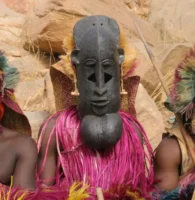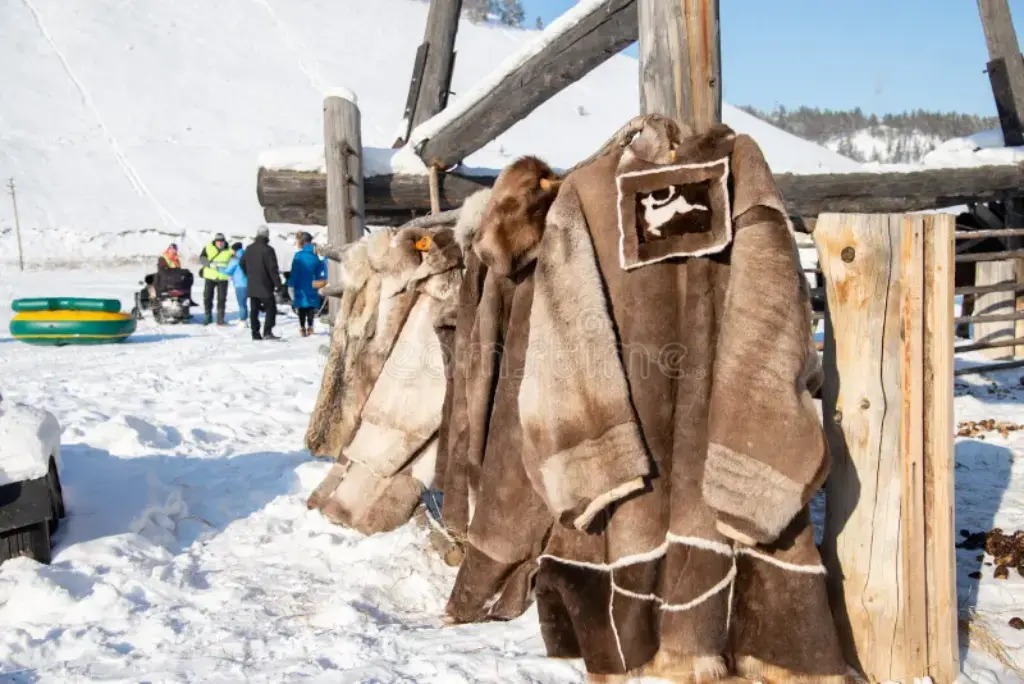Surviving the Coldest Inhabited Places on Earth
The Yakut, or Sakha, are an indigenous Turkic people numbering about 480,000, primarily residing in the Sakha Republic (Yakutia), eastern Siberia, Russia—a region known for its extreme climate, with winter temperatures dropping to -50°C or lower, making it one of the coldest inhabited places on Earth.
Their traditional winter clothing, developed over centuries, is a masterpiece of functionality and cultural expression, designed to ensure survival in brutal Siberian winters while embodying spiritual beliefs, social status, and connections to nature. Crafted from locally sourced animal furs (reindeer, sable, fox, wolf) and hides, these garments feature intricate embroidery, vibrant colors, and symbolic patterns influenced by Turkic, Mongol, and Russian traditions.
Women’s attire is particularly elaborate, while men’s is more practical but still culturally significant. The costumes are worn for daily survival, festivals like Yhyakh (summer, with winter styles adapted), and rituals, reflecting the Yakut’s resilience and deep ties to their environment.
See also The Iconic Traditional Dogon Costume: A Cultural Treasure
The Iconic Traditional Dogon Costume: A Cultural TreasureMaterials and Craftsmanship
- Fabrics and Furs: Primarily reindeer, sable, fox, or wolf pelts for insulation, with sheepskin or horsehide for durability. Inner linings use softer furs (e.g., squirrel). Leather and suede form structural components, while cloth (cotton, silk) is used post-Russian contact (18th–19th centuries).
- Dyes and Embroidery: Natural dyes (e.g., berries, bark) produce black, red, and green hues; modern synthetic dyes add vibrancy. Embroidery features geometric patterns, floral motifs, and spiritual symbols (e.g., fertility deities) using colored threads, beads, and silver ornaments.
- Production: Women hand-sew garments, tanning hides and stitching furs with sinew or thread. Silver and copper ornaments are crafted by skilled artisans, often men, using techniques like engraving and repoussé. Production is labor-intensive, with a single fur coat taking weeks to months.

Women’s Winter Attire
Yakut women’s winter clothing is both functional and ornate, designed for warmth in -60°C conditions and as a cultural statement during festivals or ceremonies. The attire emphasizes layering, vibrant colors, and protective symbolism.
- Fur Coat (Buuktaakh Ilikytyylaakh Son):
- A knee-to-ankle-length coat made of reindeer or fox fur, lined with softer fur for warmth. Black is the dominant base color, symbolizing Mother Earth, with red, yellow, or green accents for life and fertility.
- Decorated with bead embroidery, silver plates, and fur trim along hems, cuffs, and shoulders. Red fabric strips (symbolizing fertility) line the hem, sides, chest, and spine, offering spiritual protection.
- Features a wide, fur-lined hood for face protection and a fitted waist for mobility.
- Hat (Diabak):
- A wide, cylindrical cap (15–20 cm) made of beaver, sable, or wolverine fur, topped with a red cloth piece (chopchuur or chechcheh) embroidered with beads and threads.
- Symbolizes the female torso and fertility deity Akhtar Aiyyhyt Khotun, with stylized designs evoking childbirth and protection.
- Adorned with silver chains, beads, or tassels for festive occasions.
- Chest and Back Decoration (Ilin-Kelin Kebiher):
- A decorative harness worn over the coat, featuring embroidered fabric and silver ornaments (plates, pendants) across the chest and back. Enhances warmth and signifies social status.
- Trousers and Leggings:
- Woolen or fur-lined trousers under the coat, paired with fur-lined leggings for extra insulation. Embroidered with simple geometric patterns.
- Boots (Eterbes):
- High, knee-length boots of reindeer or horsehide, lined with fur (often rabbit or squirrel). Soles are thick to prevent heat loss, with decorative stitching or beadwork.
- Accessories:
- Embroidered mittens (sometimes horsehair-braided for men’s influence), fur-lined gloves, and scarves.
- Silver jewelry (necklaces, earrings) with spiritual motifs, often inherited as heirlooms.
Men’s Winter Attire
Men’s attire prioritizes practicality for hunting, herding, and survival, with less ornamentation but cultural significance during rituals or festivals like Yhyakh.
- Fur Coat (Son):
- A shorter, knee-length coat of reindeer or wolf fur, less decorated than women’s but with fur trim and simple embroidery (e.g., along seams).
- Black or brown base with red or green accents; lined with soft fur for warmth.
- Trousers:
- Thick woolen or hide trousers, often paired with fur-lined leggings for extreme cold. Simple stitching for durability.
- Hat (Kyl Seleeppe):
- A braided horsehair cap, sometimes fur-lined, or a fur hat (sable, fox) for warmth. Less ornate than women’s diabak but may include beadwork for festivals.
- Boots:
- Similar to women’s eterbes, made of reindeer hide with fur linings, designed for snow mobility.
- Accessories:
- Wide leather belts with silver buckles, fur-lined mittens, and shawls for shoulder warmth.
- During festivals, men may wear vests with minimal silver or bead ornaments.
Cultural and Social Significance
- Symbolism: Black represents Mother Earth, red symbolizes life and protection, and embroidery patterns (e.g., spirals, trees) connect to shamanistic beliefs and nature deities. The diabak hat links to fertility and spiritual protection, worn during rituals like weddings or Yhyakh.
- Social Role: Clothing denotes status—elaborate silver and embroidery signify wealth or marital status. Women’s attire is central to cultural identity, preserved through generations.
- Festivals and Rituals: Winter clothing is adapted for summer Yhyakh (celebrating renewal), with lighter furs but similar designs. Ceremonial attire includes role-reversal elements (e.g., men wearing women’s hats in jest).
- Preservation Challenges: Russian influence introduced brighter colors and cloth post-18th century, but core fur-based designs persist. Tourism and modernization threaten authenticity, though cultural programs (e.g., at North-Eastern Federal University, Yakutsk) promote preservation.
- Modern Adaptations: Younger Yakut blend traditional furs with modern fabrics, but heirloom pieces remain prized for festivals.
 Huli Wigmen Tribal Costume: Papua New Guinea’s Iconic Symbol
Huli Wigmen Tribal Costume: Papua New Guinea’s Iconic Symbol
